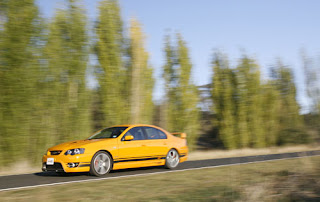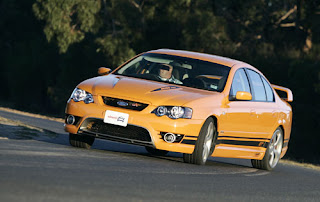We Aussies find it amusing that our most American-inspired cars turn out to be so inspiring to Americans. As you've heard, General Motors is plugging a gap in its performance credibility with the Australian-built Holden Commodore SS, which will become the 2008 Pontiac G8.
It seems to us that the 2007 Ford Falcon GT would be a good choice for you Yanks as well. Ford's Interceptor Concept from the 2007 Detroit Auto Show and its 427 concept from the 2003 Detroit show suggest Dearborn also has a hankering for a full-size, rear-wheel-drive, high-performance sedan, and the Ford Falcon here in Australia is the most obvious candidate.
The large, rear-drive V8-powered sedan took root here in the Antipodes exactly 40 years ago, when Ford Australia introduced its Mustang-bred Falcon XR GT 289. Since then, an environment of sunshine, beer and barbecues has made the Falcon the kind of car that should be sold in America.
And You Thought NASCAR Came From the Deep South
Ford might squander the credibility of its nameplates in other countries, but the "Falcon GT" moniker has never been used lightly at Ford Australia. The seminal 1967 Falcon XR GT went right into competition once it was launched and finished 1st and 2nd in the annual Bathurst 500-mile touring car race. The victory prompted Holden to fight back with its first Monaro, using an imported Chevrolet 327-cid V8 in its Bathurst racer.
Epic battles between the Falcon and Monaro ensued through the 1970s, until Ford Australia unwisely dropped its V8 option from the Falcon range in November 1982. It was 10 years before the Ford V8 (known as the "blue bent-eight" by the locals) came back into production, losing a whole generation of Ford buyers to performance-minded Holden.
So influential and fondly remembered is the original Falcon GT that a low-mileage yet historically unremarkable example of the 1971 XY Falcon GTHO Phase 3 — in its day, the world's fastest four-door — sold at auction for a record U.S. $567,293. Makes you wonder what the Falcon driven by Max Rockatansky (you know, Mad Max) would fetch. The Flight of the Falcon
The Flight of the Falcon
As with the Holden Commodore, these days the Ford Falcon does most of its business as a six-cylinder fleet-and-family car. In fact, V8 variants constitute roughly 15 percent of each car's sales. Holden uses the 6.0-liter pushrod LS2 imported for this purpose, while Ford has a locally assembled 5.4-liter SOHC unit.
Your Falcon enthusiast can choose among a 310-horsepower 24-valve SOHC V8, 350-hp 32-valve DOHC performance Falcon XR8 or a turbocharged 330-hp inline-6 XR6 Turbo.
And then there are the image-making, limited-edition Falcons from factory-owned hot-rod shops like Ford Performance Vehicles (FPV). Back in 2003, FPV partnered with ProDrive (the English motorsports engineering specialist) and finally got Ford's performance-brand image together. Today the collaboration supplies FPV with a range of sedans powered by either a 362-hp version of the turbocharged inline-6 or a 389-hp DOHC V8. Emotional Engineering
Emotional Engineering
Named for its output in kilowatts, the "Boss 290" engine in our bright-orange FPV Ford Falcon GT test car is a transpacific freak. The 5.4-liter V8 uses a Mustang Cobra R block and 32-valve DOHC cylinder heads from America, while the pistons, bearings, inlet manifold and exhaust headers are sourced in Australia.
FPV maintains that it doesn't want to get involved in a horsepower war with Holden Specialty Vehicles (HSV), which is an elegant way of conceding defeat before you've even left the showroom. While FPV's slogan of "total performance" applies to the well-integrated package of accessories worn by this Falcon GT, the hardware isn't especially exciting.
There's the engine, for instance. With not much happening underfoot until the tachometer needle swings past 3,500 rpm, you're thinking this quad-cam V8 must be a screamer. But no sooner has the V8 begun to come alive than it gets breathless beyond 5,500 rpm and finally splatters against the rev limiter at 6,000 rpm.
There's no alternative but to dip the long-throw clutch pedal again and have a grumble through the knuckly gate of the six-speed manual transmission. The first four cogs are nicely useful, but the direct-drive 5th and overdrive 6th leave the V8 snoozing at the 70-mph speed limit ruthlessly enforced on Australian freeways.
With a 0-60-mph time of 5.7 seconds and a quarter-mile run of 14.5 seconds at 98.9 mph, the Falcon GT is slower than the Holden Commodore SS, which itself gets to 60 mph in 5.3 seconds on its way to the quarter-mile in 14.1 seconds at 99.1 mph. You've Mellowed These Last 40 Years
You've Mellowed These Last 40 Years
In many ways, however, the Falcon GT is admirably swift and competently composed.
Most remarkable is the ride quality, as it's very comfortable across all but the most patchy surfaces, where the body control begins to suffer from the combination of limited suspension travel and soft rebound damping. It's a useful achievement considering the car's aggressive 245/35R19 tires.
In GT trim, the Falcon's double-wishbone front suspension and independent multilink rear suspension get a lower ride height with unique springs, dampers and antiroll bar. But the Falcon's curb weight of 4,090 pounds sabotages the car's handling at the limit. One also has to remember that this is a big car: just a fraction of an inch shorter than the .
We managed a slalom run of 64.9 mph and then recorded 0.84g around the skid pad. The Ford is agile enough to be entertaining, but not swift enough to keep up with the Holden's 67.6-mph slalom speed and its 0.87g skid pad performance.
The Falcon's steering isn't fazed much by road undulations and its turn-in is consistent and quick, but the thick-rimmed steering wheel transmits more hydraulic effort than road feel. The seats feel good, though the support is compromised by the need to accommodate our big, beefy Aussie frames.
We Don't Slow Down Much in Australia
Even these bold, baboon-butt Brembo brakes don't deliver fully on their promise. While pedal modulation feels great, the Falcon GT came to a stop from 60 mph in 122 feet, 5 feet longer than the stop recorded by the Holden Commodore SS we tested on the same day. It seems like a disappointing performance from such an expensive brake package with six-piston front calipers and four-piston rears.
Slightly oversensitive calibration of the ABS also flusters braking performance over road ripples, making apex-picking a challenge during press-on, open-road punting.
Well, all of that's true in Australia, anyway. Our roads vary from divided highways to wandering tracks across the Outback, so it's easy to turn up the compromises that must be built into a platform that must be sufficiently tough for daily dirt-road use, yet sophisticated enough to aspire to the performance of a European sport sedan.
You know what it is? The Falcon GT's shortcomings are the things that make it feel to Australian drivers as if it's a bit, well, American.
Winging Its Way to Where?
The Aussie Falcon's future has been debated for about as long as Dearborn has lacked a decent platform for a large rear-drive sedan.
It seems that each new generation of the Falcon is predicted to be its last, as smaller international platforms (like the DEW98 platform beneath the current Ford Mustang and Jaguar S-Type) are constantly tipped to replace this Aussie-engineered production, which is as old as grandfather's axe.
Next to the VE Commodore, however, the Falcon does feel a generation older. That's why a substantial revision of the Falcon platform is due next year, we're told. Apparently Ford will address the Falcon's dull feel from the front tires with a stronger front subframe, new lower wishbones for the front suspension and a new steering system.
Almost certainly, however, this new car will be the last unique, all-Aussie Falcon. The next-generation platform, due around 2012, will be shared with Ford's rear-drive U.S. models. If we're lucky, Dearborn will have learned a few things from the Aussies by then.
[sourcing: http://www.edmunds.com/]
Full Test: 2007 FPV Ford Falcon GT A Four-Door Mustang From Down Under
Label:
Drive Experience,
Ford,
FPV,
Luxury Car,
Test Drive